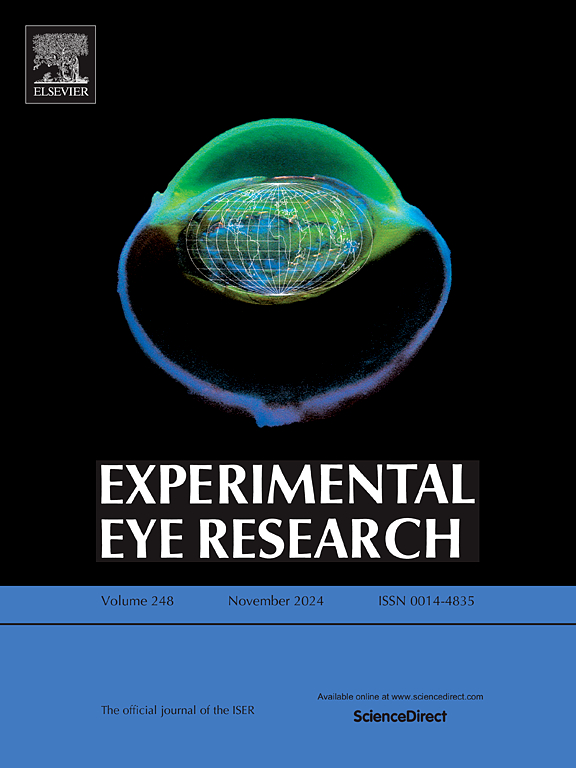Distinct activation of M1 and M2 macrophages in the primary pterygium lymphangiogenesis
IF 3
2区 医学
Q1 OPHTHALMOLOGY
引用次数: 0
Abstract
The precise role and innate immunological mechanisms underlying lymphangiogenesis in pterygium remain unclear. This study aimed to investigate the presence of M1 and M2 macrophages and their correlation with pro-lymphangiogenic activation and lymphatic endothelial expression in human pterygium stromal tissues. We analyzed human pterygium and subject-matched normal conjunctival tissues for the expression of these factors and conducted in vitro experiments to assess interactions between macrophages and pterygium fibroblasts. Myeloid and M1 macrophage markers were upregulated in pterygium. M1 macrophages were associated with the upregulation of pro-lymphangiogenic vascular endothelial growth factor C (Vegfc) in pterygium tissues and induced inflammatory signals in pterygium fibroblasts. In contrast, lymphatic vessel endothelial hyaluronan receptor 1 (Lyve1) expression was associated with M2 markers but not with M1 markers. Notably, the clinical severity of pterygium was inversely correlated with the expression of the M2 marker Cd163. These findings suggest that M1 and M2 macrophages play distinct roles in the pathogenesis of pterygium, with M1 macrophages enhancing lymphangiogenic stimulation and inflammatory responses, while M2 macrophages are associated with Lyve1 expression and reduced severity of pterygium. Understanding these mechanisms may advance our current understanding of lymphatic biology in pterygium.
原发性翼状胬肉淋巴管生成过程中 M1 和 M2 巨噬细胞的不同激活方式
翼状胬肉淋巴管生成的确切作用和先天性免疫机制仍不清楚。本研究旨在调查人翼状胬肉基质组织中 M1 和 M2 巨噬细胞的存在及其与促淋巴管生成活化和淋巴内皮表达的相关性。我们分析了人翼状胬肉和与受试者匹配的正常结膜组织中这些因子的表达情况,并进行了体外实验来评估巨噬细胞与翼状胬肉成纤维细胞之间的相互作用。在翼状胬肉中,髓系和 M1 巨噬细胞标记上调。M1巨噬细胞与翼状胬肉组织中促淋巴管生成的血管内皮生长因子C(Vegfc)的上调有关,并诱导翼状胬肉成纤维细胞出现炎症信号。相反,淋巴管内皮透明质酸受体 1(Lyve1)的表达与 M2 标志物有关,而与 M1 标志物无关。值得注意的是,翼状胬肉的临床严重程度与 M2 标记 Cd163 的表达成反比。这些发现表明,M1 和 M2 巨噬细胞在翼状胬肉的发病机制中扮演着不同的角色,M1 巨噬细胞会增强淋巴管生成刺激和炎症反应,而 M2 巨噬细胞则与 Lyve1 表达和翼状胬肉严重程度的降低有关。了解这些机制可促进我们目前对翼状胬肉淋巴生物学的理解。
本文章由计算机程序翻译,如有差异,请以英文原文为准。
求助全文
约1分钟内获得全文
求助全文
来源期刊

Experimental eye research
医学-眼科学
CiteScore
6.80
自引率
5.90%
发文量
323
审稿时长
66 days
期刊介绍:
The primary goal of Experimental Eye Research is to publish original research papers on all aspects of experimental biology of the eye and ocular tissues that seek to define the mechanisms of normal function and/or disease. Studies of ocular tissues that encompass the disciplines of cell biology, developmental biology, genetics, molecular biology, physiology, biochemistry, biophysics, immunology or microbiology are most welcomed. Manuscripts that are purely clinical or in a surgical area of ophthalmology are not appropriate for submission to Experimental Eye Research and if received will be returned without review.
 求助内容:
求助内容: 应助结果提醒方式:
应助结果提醒方式:


